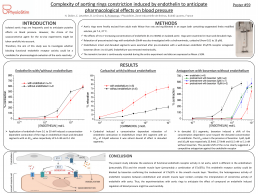Complexity of aortic rings constriction induced by endothelin to anticipate pharmacological effects on blood pressure
Printemps R, Didier H, Le Grand B, Letzelter C, PhysioStim, Zone Industriellede Brénas, 81440 Lautrec, France.

Isolated aortic rings are frequently used to anticipate putative effects on blood pressure. However, the choice of the vasoconstrictive agent for the ex-vivo experiments might be taken carefully into account. Therefore, the aim of this study was to investigate whether blocking functional endothelin receptor activity could be a candidate for pharmacological evaluation of the aorta reactivity. In vitro, the effect of endothelin was determined by measurement of isometric contractions in isolated rat aortic arteries. Endothelium intact (E+) and de-endothelialized (E-) segments were examined after pre-incubated with a well-known endothelin ETa/ETb receptor antagonist: bosentan (from 1 to 10 µM). Relaxation of precontracted rings with endothelin was investigated with a cholinomimetic: carbachol (from 0.01 to 10 µM). Application of endothelin from 0.1 to 30 nM induced a concentration-dependent contraction of the rings in endothelium intact (E+) and de-endothelialized (E-) segments with an EC50 value respectively of 9.4 nM and of 5.1 nM. In de-endothelialized (E-) segments, bosentan induced a shift of the concentration dependent curve toward the elevated concentration of endothelin. For example, the EC50 value in the presence of bosentan 10 µM was 61.5 nM vs 5.1 nM without bosentan. This parallel shift of the curve clearly suggested a competitive antagonism against the ET receptor. Finally, carbachol induced a concentration dependent relaxation of endothelin contraction in endothelium intact (E+) segment with an EC50 of 0.3µM whereas it was devoid of significant effect in de-endothelialized (E-) segments. In conclusion, the present study indicates the existence of functional endothelin receptor activity in rat aorta artery, which is different in the endothelium (presumably ETb) and the smooth muscle layer (presumably a combination of ETa/ETb). This endothelin receptor activity could be blocked by bosentan confirming the involvement of ETa/ETb in the smooth muscle layer. Therefore, the heterogenous activity of endothelin receptors between endothelium and smooth muscle layer renders complex the interpretation of constrictive activity of endothelin with aorta. Thus, the experimentations with aortic rings to anticipate the effect of compound on endothelin induced regulation of blood pressure might be used carefully.